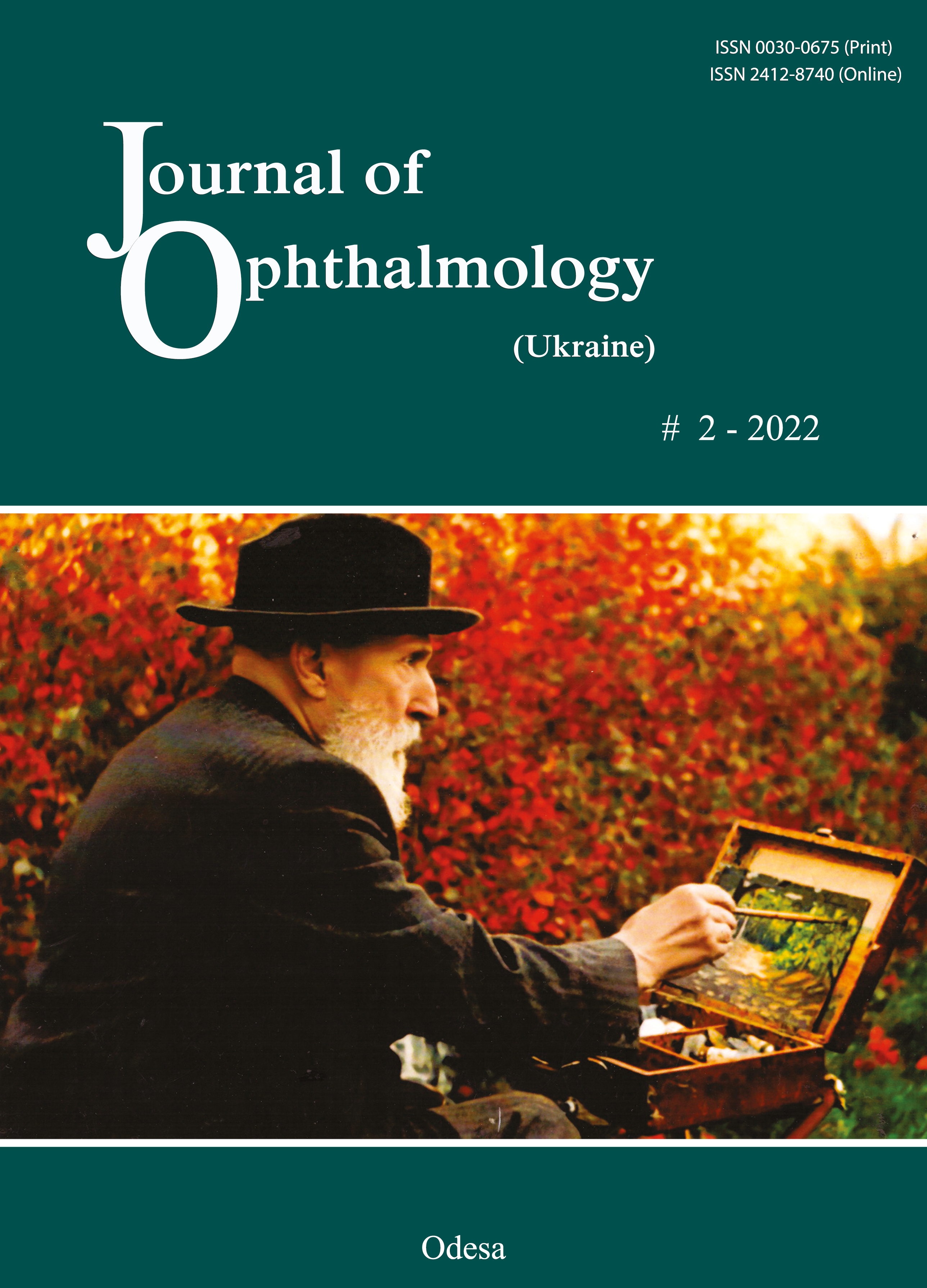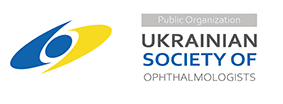Optical coherence tomography angiography as an indicator of the efficacy of treatment for choroidal neovascularization
DOI:
https://doi.org/10.31288/oftalmolzh202221520Keywords:
choroidal neovascularization, anti-VEGF therapy, optical coherence tomography angiography, pathological myopiaAbstract
Background: Choroidal neovascularization (CNV) occurs in as much as 11.3% of patients with pathological myopia, and is a major cause of visual disability associated with irreversible loss of central vision. The advent of optical coherence tomography angiography (OCTA) has opened up new opportunities for objective documentation and real-time qualitative and quantitative evaluation of CNV in the course of therapy.
Purpose: To assess the efficacy of anti-vascular epithelium growth factor (VEGF) therapy with ranibizumab in CNV associated with pathological myopia using OCTA.
Material and Methods: Thirty seven anti-VEGF-treatment naive patients (37 eyes) with myopic CNV were involved in the study. All study participants received an intravitreal ranibizumab injection (in accordance with the manufacturer’s recommendations) followed by as needed (PRN) retreatment.
Results: Complete subretinal fluid resorption with adherence of the neurosensory retina was observed in all the 37 eyes; the mean number of intravitreal ranibizumab injections required was 4.56 ± 0.1. Over the 18-month follow up period, best-corrected visual acuity (BCVA) improved from 0.12 ± 0.03 to 0.42 ± 0.04 in 27 eyes (72.97%). OCTA patterns of CNV activity tended to fade, with the characteristic presence of isolated long filamentous vessels having a “dead tree” appearance.
Conclusion: Application of OCTA, an information-rich modality, in pathological myopia, facilitates a personalized approach to determining the need for anti-VEGF therapy and selecting the mode of administration of anti-VEGF agents based on the CNV activity.
References
1.Chan WM, Ohji M, Lai TYY, Tano Y, Lam DSC. Choroidal neovascularization in pathological myopia: an update in management. Br J Ophth. 2005 Nov;89(11):1522-8. https://doi.org/10.1136/bjo.2005.074716
2.Min CH , Al-Qattan HM, Lee JY, Kim J-G. Macular Microvasculature in High Myopia without Pathologic Changes: An Optical Coherence Tomography Angiography Study. Korean J Ophthalmol. 2020 Apr; 34(2): 106-12. https://doi.org/10.3341/kjo.2019.0113
3.Hayashi K, Ohno-Matsui K, Shimada N, et al. Long-term pattern of progression of myopic maculopathy: a natural history study. Ophthalmology. 2010 Aug;117(8):1595-611, 1611.e1-4. https://doi.org/10.1016/j.ophtha.2009.11.003
4.Holden BA, Fricke TR, Wilson DA, et al. Global prevalence of myopia and high myopia and temporal trends from 2000 through 2050. Ophthalmology. 2016 May;123(5):1036-42. https://doi.org/10.1016/j.ophtha.2016.01.006
5.Tufail A, Narendran N, Patel PJ, et al. Ranibizumab in myopic choroidal neovascularization: the 12 month results from the REPAIR study. Ophthalmology. 2013 Sep;120(9):1944-5.e1. https://doi.org/10.1016/j.ophtha.2013.06.010
6.Wolf S, Balciuniene VJ, Laganovska G, et al. RADIANCE: a randomized controlled study of ranibizumab in patients with choroidal neovascularization secondary to pathologic myopia. Ophthalmology. 2014 Mar;121(3):682-92.e2. https://doi.org/10.1016/j.ophtha.2013.10.023
7.Neelam K, Cheung CM, Ohno-Matsui K, et al. Choroidal neovascularization in pathological myopia. Prog Retin Eye Res. 2012 Sep;31(5):495-525. https://doi.org/10.1016/j.preteyeres.2012.04.001
8.Raecker ME, Park D.-W, Lauer AK. Diagnosis and treatment of CNV in myopic macular degeneration. Eye Net Magazine. 2015: 35-7.
9.Wong TY, Ohno-Matsui K, Leveziel N, et al. Myopic choroidal neovascularization: current concepts and update on clinical management. Br J Ophthalmol. 2015 Mar;99(3):289-96. https://doi.org/10.1136/bjophthalmol-2014-305131
10.Ng WY, Ting DS, Agrawal R, et al. Choroidal structural changes in myopic choroidal neovascularization after treatment with Antivascular endothelial growth factor over 1 year. Invest Ophthalmol Vis Sci. 2016 Sep 1;57(11):4933-9. https://doi.org/10.1167/iovs.16-20191
11.Wang Y, Hu Z, Zhu T, et al. Optical Coherence Tomography Angiography-Based Quantitative Assessment of Morphologic Changes in Active Myopic Choroidal Neovascularization During Anti-vascular Endothelial Growth Factor Therapy. Front Med (Lausanne). 2021 May 7;8:657772. https://doi.org/10.3389/fmed.2021.657772
12.Venediktova OA, Saksonov SG, Suk SA. [Diagnostic value of optical coherence tomography and fluorescein angiography in the evaluation of the dynamics of regression of classical subretinal neovascular membranes at high-complicated myopia after combined use of ranibizumab and transpupillary thermotherapy]. Ukrainian Scientific Medical Youth Journal. 2012; 2:53 55. Russian.
13.Coscas G, Lupidi M, Coscas F, Français C, Cagini C, Souied EH. Optical coherence tomography angiography during follow-up: qualitative and quantitative analysis of mixed type I and II choroidal neovascularization after vascular endothelial growth factor trap therapy. Оphthalmic Res. 2015;54(2):57-63. https://doi.org/10.1159/000433547
14.Coscas GJ, Lupidi M, Coscas F, Cagini F, Souied EH. OCTA versus traditional multimodal imaging in assessing the activity of exudative AMD. A new diagnostic challenge. Retina. 2015 Nov;35(11):2219-28. https://doi.org/10.1097/IAE.0000000000000766
Downloads
Published
How to Cite
Issue
Section
License
Copyright (c) 2025 Ф. А. Бахритдінова, З. Р. Максудова, Н. А. Усманова, Ф. М. Урманова

This work is licensed under a Creative Commons Attribution 4.0 International License.
This work is licensed under a Creative Commons Attribution 4.0 International (CC BY 4.0) that allows users to read, download, copy, distribute, print, search, or link to the full texts of the articles, or use them for any other lawful purpose, without asking prior permission from the publisher or the author as long as they cite the source.
COPYRIGHT NOTICE
Authors who publish in this journal agree to the following terms:
- Authors hold copyright immediately after publication of their works and retain publishing rights without any restrictions.
- The copyright commencement date complies the publication date of the issue, where the article is included in.
DEPOSIT POLICY
- Authors are permitted and encouraged to post their work online (e.g., in institutional repositories or on their website) during the editorial process, as it can lead to productive exchanges, as well as earlier and greater citation of published work.
- Authors are able to enter into separate, additional contractual arrangements for the non-exclusive distribution of the journal's published version of the work with an acknowledgement of its initial publication in this journal.
- Post-print (post-refereeing manuscript version) and publisher's PDF-version self-archiving is allowed.
- Archiving the pre-print (pre-refereeing manuscript version) not allowed.












